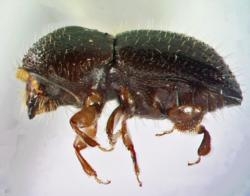A recent publication from CA Fish and Wildlife has some wonderful photos of trees that have been known to be attacked by either or both of the Shot Hole Borers, Polyphagous or Kuroshio. The publication can be found at:
The most current listing of hosts and the distribution of the beetles can be found at Akif Eskalen's website:
http://eskalenlab.ucr.edu/distribution.html
Introduction
Shot hole borers (SHB) and Fusarium dieback (FD) represent an increasing threat to many plant species in southern California. Two similar species of invasive shot hole borer exist in southern California, the Polyphagous shot hole borer (PSHB) and the Kuroshio shot hole borer (KSHB) (Euwallacea spp). Shot hole borers are ambrosia beetles forming a symbiotic relationship with the fungi. PSHB symbionts are Fusarium euwallaceae, Graphium euwallaceae, and Paracremonium pembeum, while KSHB forms a symbiotic relationship with two novel species of Fusarium and Graphium (Cooperband et al. 2016) (Lynch et al. 2016) (Eskalen, Stouthamer 2015). These fungi clog the host's vascular tissue leading to branch dieback and eventually tree death. The beetles are not pathogenic in their native habitats in Southeast Asia, preferring instead to infect stressed trees (Hulcr and Dunn 2011). The two shot hole borer species found in southern California differ primarily in the fungal species they associate with but can be treated the same for the sake of management.
SHB infestations begin when females burrow natal galleries into the host, introduce symbiotic fungi, and lay eggs. Females are capable of producing haploid male offspring in the absence of mating while mated females produce diploid female offspring. Eggs mature into adults in six weeks. Beetle emergence occurs over a period of weeks during the spring and summer. Dispersal of females to other hosts is primarily wind-driven, but is also likely facilitated by firewood and green waste movement. Males are incapable of flight; they remain on the host tree but may enter other natal galleries (Umeda, Eskalen, and Paine 2016). Beetle dispersal can occur over large distances if winds allow.
The loss of wildland trees, particularly in riparian areas, poses a threat to numerous threatened and endangered species such as the least Bell's vireo (Vireo bellii pusillus). Destroyed forests give way to invasive species such as giant reed (Arundo donax) and castor bean (Ricinus communis) (Boland 2016). Specifics of this emerging threat are poorly understood and while research is ongoing this guide is intended as an identification aid for land managers in areas where SHB may not yet be discovered.
(references are found at the end of the publication)
Attached Images:
